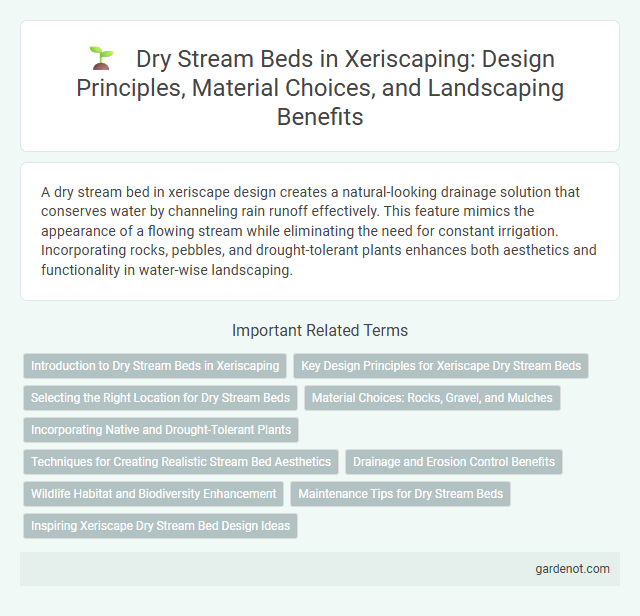A dry stream bed in xeriscape design creates a natural-looking drainage solution that conserves water by channeling rain runoff effectively. This feature mimics the appearance of a flowing stream while eliminating the need for constant irrigation. Incorporating rocks, pebbles, and drought-tolerant plants enhances both aesthetics and functionality in water-wise landscaping.
Introduction to Dry Stream Beds in Xeriscaping
Dry stream beds in xeriscaping mimic natural waterways using rocks, gravel, and drought-tolerant plants to manage water runoff and prevent soil erosion. These features enhance water conservation by directing rainwater efficiently into the landscape while adding aesthetic appeal with natural textures and patterns. Incorporating native, low-water-use vegetation further supports sustainable irrigation practices in xeriscaped gardens.
Key Design Principles for Xeriscape Dry Stream Beds
Xeriscape dry stream beds mimic natural water flow using carefully selected, drought-tolerant plants and porous materials like gravel and river rocks to facilitate drainage and prevent erosion. Strategic placement of native vegetation and contouring of the landscape ensures efficient water infiltration while reducing runoff. Incorporating varied textures and sizes of stones enhances visual interest and supports sustainable, low-maintenance landscaping.
Selecting the Right Location for Dry Stream Beds
Choosing the right location for dry stream beds involves identifying areas with natural water flow or low spots in the landscape that can mimic stream channels. Ideal sites should have well-draining soil and be positioned to capture runoff without causing erosion or pooling. Ensuring the chosen location complements surrounding xeriscape plants enhances water conservation and visual appeal in drought-tolerant landscapes.
Material Choices: Rocks, Gravel, and Mulches
Dry stream beds in xeriscape design primarily utilize durable material choices such as rounded river rocks, angular gravel, and organic mulches to effectively manage water flow and enhance aesthetic appeal. River rocks provide erosion control and natural texture, while gravel aids drainage and prevents soil compaction, and mulches help retain moisture and suppress weeds. Selecting appropriate sizes and colors of these materials optimizes functionality and complements drought-tolerant plantings in sustainable landscaping.
Incorporating Native and Drought-Tolerant Plants
Dry stream beds effectively manage water runoff while enhancing landscape aesthetics using native and drought-tolerant plants such as blue grama grass, penstemon, and desert willow. These plants improve soil stabilization and reduce irrigation needs by thriving in arid conditions and mimicking natural riparian environments. Incorporation of deep-rooted species fosters water absorption and supports local biodiversity within xeriscape designs.
Techniques for Creating Realistic Stream Bed Aesthetics
Techniques for creating realistic dry stream bed aesthetics focus on selecting appropriately sized rocks and natural gravel to mimic the flow and texture of water movement. Incorporating native drought-tolerant plants and strategically placing smooth river stones enhances authenticity and promotes water conservation. Proper grading ensures effective drainage while maintaining the visual appeal of a natural, sustainable landscape feature in xeriscape design.
Drainage and Erosion Control Benefits
A dry stream bed enhances xeriscape drainage by directing excess water away from vulnerable areas, preventing soil saturation and promoting efficient water runoff. Its design minimizes erosion by stabilizing slopes with rocks and gravel, reducing the impact of heavy rainfall and surface runoff. This natural drainage solution improves landscape durability while conserving water in arid environments.
Wildlife Habitat and Biodiversity Enhancement
Dry stream beds in xeriscaping create vital wildlife habitats by offering shelter and water flow simulation for local fauna. These features enhance biodiversity by supporting native plants and attracting pollinators, birds, and small mammals. Integrating dry stream beds helps maintain ecological balance while conserving water in arid landscapes.
Maintenance Tips for Dry Stream Beds
Regularly removing debris and fallen leaves from dry stream beds prevents blockage and maintains water flow during rains. Inspecting the stone arrangement and re-leveling displaced rocks ensures structural integrity and aesthetic appeal. Incorporating drought-tolerant plants alongside the dry stream bed reduces watering needs and helps control soil erosion effectively.
Inspiring Xeriscape Dry Stream Bed Design Ideas
Inspiring xeriscape dry stream bed design ideas emphasize natural stone arrangements paired with drought-tolerant plants like succulents and ornamental grasses. Integrating river rocks and gravel enhances water conservation while creating a visually appealing landscape feature that directs water flow during heavy rainfall. Using native plants such as blue grama grass and yucca strengthens the environment-friendly aspect and reduces irrigation needs for sustainable xeriscaping.
Dry stream bed Infographic

 gardenot.com
gardenot.com